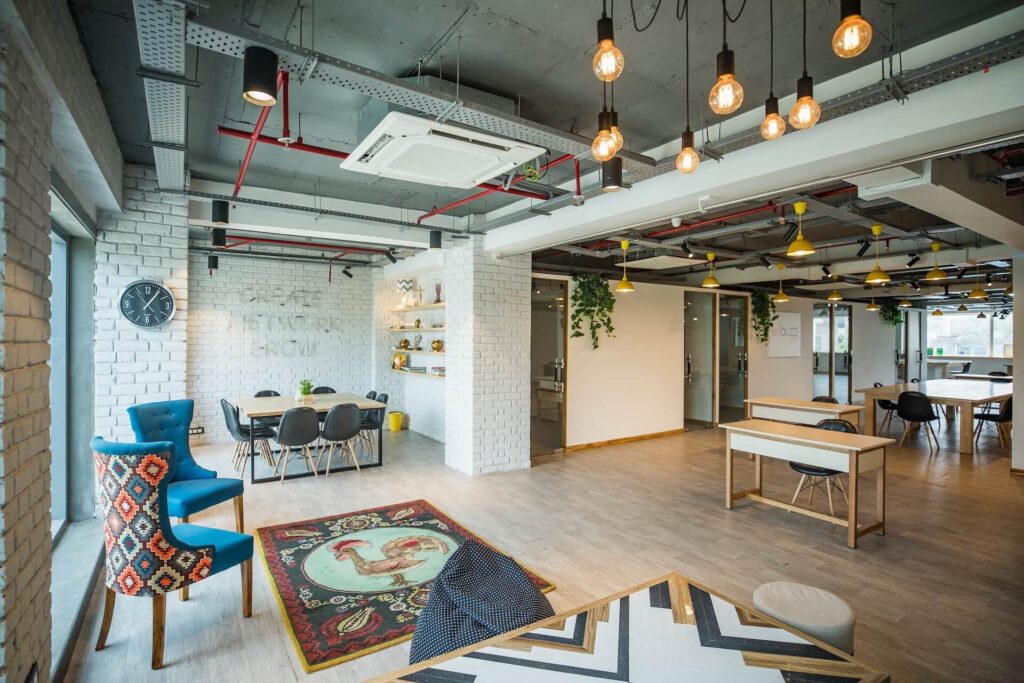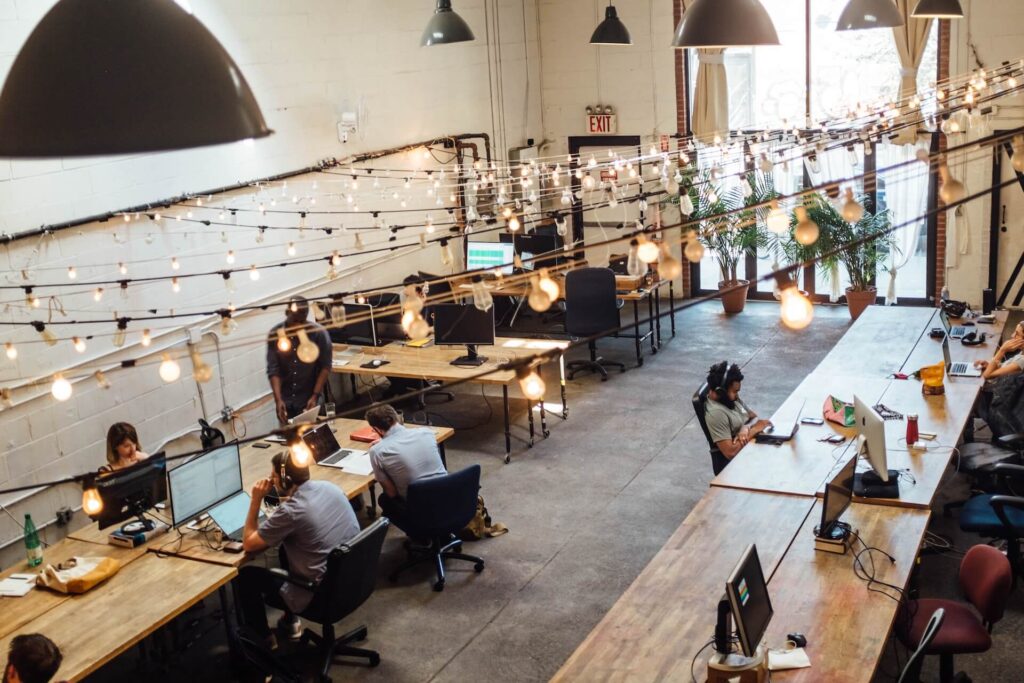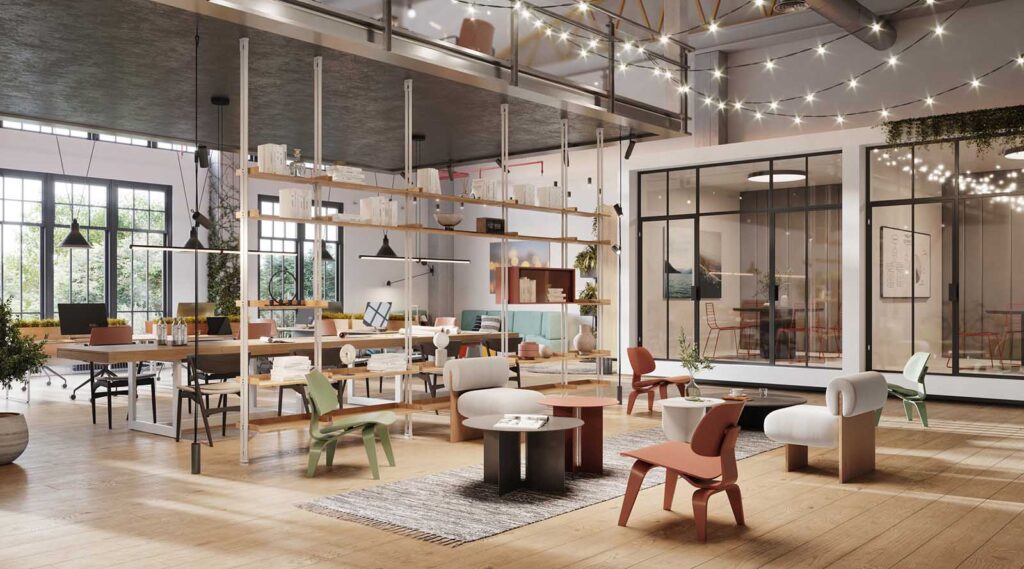Hot desking productivity is important to consider when deciding whether or not to implement this (or any other) workplace strategy.
While trying to create a better office in our ‘new normal’ of flexible and hybrid work, business leaders and facility managers (FMs) are now looking at a variety of workplace trends.
Of course, no new work environment type is ever a guarantee. The success of any working model—including hot desking—will ultimately come down to how well it’s implemented.
In this article, we explore hot desking productivity. We also review how shared workspaces are evolving with the return to the office. We’ll also delve into the best ways to create a hot desking solution that’s not only more productive, but also creates a better workplace experience for everyone.
Hot desking, hybrid work, and workplace flexibility
Thanks to the pandemic and the now entrenched employee demand for more flexibility, the office has changed—perhaps forever. A variety of flexible work arrangements are coming to the forefront. This is in an effort to to improve the hybrid workplace experience.
Sometimes called a ‘non-territorial workplace,’ a hot desking environment is a form of free addressing. This is where employees no longer have assigned desks.
Instead, they check into available desks each morning, ideally with the help of robust desk booking software.
Some companies are also offering the option to have a variety of types of bookable desks. This is along with dedicated desks, as well. For example, it might be relegated to different departments or different sections of the office.
In other words, hot desking offers many solutions for the workplace. It doesn’t have to be ‘all or nothing.’
While this seating arrangement is far from the norm, it’s on the rise. 19% of employees in the US have no assigned desk. This is due in large part to lessons learned from the pandemic. It’s also due to the growing awareness of how to improve the productivity and efficiency of hot desking.
Of course, as with anything new, there can be growing pains, and there can certainly be drawbacks with hot desking. As we’ll explore below, there are some simple strategies that workplaces can often use to overcome these challenges.
Bottom line: we’re in a new era of flexible working. Companies that work now to get hot desking ‘right’ have the potential to dramatically change their productivity and employee engagement for the better.
What is the difference between hot desking and open plan offices?
Companies often use hot desking in open plan offices, but the two are not synonymous.
Meanwhile, open plan offices (often simply called ‘open offices’) are the popular working environment that eschews private offices and cubicles in favor of wide open working spaces.
As with hot desking, the productivity and benefits of open offices will largely come down to how well companies implement them. This includes how willing they are to make changes when necessary.
Done in the correct way, hot-desking can provide a number of opportunities in any office environment for both staff and the overall business.
Cal Lee, Verdict

Does hot desking improve productivity?
To date, we don’t have many academic studies specifically focused on the actual productivity of hot desking.
That said, we do know that hot desking has the potential to decrease productivity.
For example, if, like one survey finds, you’re spending 18 minutes a day looking for a desk, then you’re certainly going to be less productive than if you had dedicated desk space.
Another study found that 30% of hot desking employees report spending time on ‘house-keeping duties’ that keep them from real work.
Implementation and experimentation
But it’s important to remember that while hot desking has been around for a long time, it’s never been as widespread as it is now. Most studies about hot desking and its impact on productivity were conducted prior to this widespread implementation and experimentation. While workplaces are actively working to figure out how to make it work best, research is still struggling to catch up.
What if facilities managers introduce desk booking options that let employees find good desks on any given day in a minute or two, versus 18?
What if good policies and digital workplace solutions dramatically reduce the amount of house-keeping duties associated with shared desks?
And what if managers worked with human resources to continually solicit employee feedback to improve their hybrid workplace?
In short, there are many solutions to dramatically boost the benefits of hot desking. One of the few post-pandemic studies of flexible work arrangements finds that “innovative planning software and tools, smart technology and apps, modern IT technology and infrastructure, and digital apps can be introduced to the workplace to help FM manage and monitor the facilities operations, workplace situations and occupancy rates.”
Finally, it’s also important to remember that productivity has dramatically improved with the pandemic-created pivot to hybrid and remote work. By up to 47%, according to some studies. In other words, flexible seating options don’t inherently hurt productivity.
All this points to one answer. Hot desking can improve productivity. But the level to which it does will largely depend on how it’s carried out from workplace to workplace.
Thankfully, we’ve already learned many best practices when it comes to introducing this and other flexible strategies.

What is the best way to make hot desking work?
Good hot desking starts at the top, with clear communication, policies, and guidance. This is why 87% of companies are introducing rules to improve hot-desking etiquette. Like not eating at your desks or not switching desks.
Beyond this, simple things like providing ready supplies to clean desks at the end of the day can help cut back on those house-keeping duties. And providing storage lockers can help alleviate staff reticence.
Since it can cut back on the number of desks needed, hot desking might create an opportunity to create a more modern office floor plan. One that brings in creative flex room ideas and lounge areas.
This, in turn, can cut back on some of the drawbacks of open offices. They can tend to be much more impersonal and make heads-down work harder than intended.
“Acres of open-plan space with hundreds of desks is unlikely to benefit anyone,” says Dr Libby Sander, assistant professor of organizational behavior at Bond University in Australia.
And hot desking often works best when it’s part of other flexible arrangements, like agile working, activity-based working, and office neighborhoods.
As we’ll explore further below, office neighborhoods in particular can help counter many of the disadvantages of this model.
“In their enthusiasm to create a better workplace environment, some leaders may forget to collect input before and throughout the process, or only seek input from a subset of people who will be using the space.”
Susan K. Hogan, John Lucker, Robbie Robertson, and Flavie Schäfer, Deloitte
Make it easy
Companies that have the most success when implementing hot desking and other free addressing setups are those that make it incredibly easy for employees to check in to desks.
Change is hard, and it can be scary to give up ‘your’ fixed desk.
That’s why companies like LogicMonitor introduced flexible working software that is accessible via mobile and desktop.
Now, when LogicMonitor employees show up to work, they can book their desk on their phone, on their laptop, or on the iPad kiosks that are in the entryways.
“It’s super easy, which is crucial for change management” says Kelly Conway, Senior Manager of Workplace Experience and Facilities.
Note that using IoT sensors can even further simplify this process. They allow people to book desks automatically and mark them as occupied.
Better still, if these IoT sensors are integrated with space management software that provides good workplace report and analytics, they can also provide FMs with invaluable information around how the office is currently being used (and how it can therefore be better optimized).
Focus on employee experience
When implementing any new workplace strategy, companies should keep the focus on employee experience. Especially any that has to deal with personal space, . The simplest way to do this is to solicit employee feedback.
“If I invest in technology or space, or if I reduce real estate because I don’t think we need as much, all of that is a potential risk with significant costs associated,” says Angie Earlywine, Director in the Total Workplace division of Global Occupier Services at Cushman & Wakefield. “The antidote to figuring out how to reduce risk is in ensuring you’re aligned with employee sentiment and the company’s vision for supporting a hybrid work environment.”
Provide visibility
Finally, providing better visibility is a must when implementing hot desking (or any other flexible working strategy).
First and foremost, employees will need good wayfinding options, especially when working in large offices. Hybrid employees in particular, who may not be as familiar with the office, will appreciate good wayfinding signs to find their way around.
But employees won’t just need an easy way to find their own desk for the day.
They’ll also need an easy way to find colleagues, who will also be moving around from day to day.
As such, a Visual Directory, which provides a real-time floorplan, can help employees. It allows them to connect with the people and resources they need.

What is the benefit of hot desking?
As a whole, shared workspaces have been linked with greater employee satisfaction. Also: closer working relationships, increased networking opportunities, and more flexibility in terms of using the physical office.
When companies turn to hot desking/shared desks, they often do so to improve space utilization. And ultimately reduce the size of their real estate portfolio.
Specifically, introducing hot-desking can reduce office size by up to 30%. This can lead to major cost savings and a smaller carbon footprint.
Hot desking can also be efficient for managing a large, distributed workforce.
Shared desks are typically desks with less clutter and fewer personal items. As a result, hot desking can also lead to a tidier workspace. Employees may really start to enjoy having an office with less visual distractions.
Beyond these tangible benefits from hot desking, there are many intangibles, too. But only when companies implement it well and with employee feedback.
Namely, employees of all generations in the workforce have been demanding more flexible options, even before the pandemic.
And today, we’re very much in an employees’ job market. The majority of workers now say they’d leave their job for another, more flexible one.
So implementing hot desking can be part of a larger strategy to introduce more flexibility and autonomy into the workplace. It can improve both the hybrid workplace and the employee experience.
This, in turn, can help with both talent retention and attraction. Both are critical now as companies grapple with the long-term effects of the Great Resignation.

What are the disadvantages of hot desking?
Let’s start with the bad news first. Hot desking certainly has the potential to cause headaches for both employees and their managers. Like we’ve covered, employees can certainly waste time trying to find a desk. Many may resist giving up their own workspace. And a lack of privacy (perceived or otherwise) can be stressful.
Now for the good news: in response to these drawbacks, many tools have sprung up to help maximize hot desking.
Specifically, like we’ve covered, desk booking software can eliminate both the ‘legwork’ and ‘guesswork’ associated with finding new desks each day.
Meanwhile, companies that have enough full time in-office employees can certainly keep a number of assigned desks to keep them happy.
A good digital workspace and a company laptop can make it so that employees have access to the same tools and technology. This is whether they’re at home, in the office, sitting in a hot desk, or patronizing the coffee shop down the street,
Many of the problems we associate with hot desking are because of wrong-headed policies and usage.
In fact, research prior to the pandemic found that organizations weren’t providing enough desks or creating layouts designed to maximize job satisfaction and teamwork. Another major study found that environmental factors like office layout and the amount of available storage space play a bigger factor in productivity and employee experience than sharing desks.
So when assessing whether hot desking is right for your organization, be sure to also assess how willing and ready you are to meet these challenges head on.
Keeping shared desks clean
One of the biggest concerns when implementing hot desking has to do with cleanliness. This, of course, is now top of mind as we’ve all learned our fair share about communicable diseases.
Shared desks of course can be a concern when it comes to health and wellness. They can host up to 18% more bacteria than personal ones.
But again—the right policies can do a lot to mitigate these risks.
Like we’ve covered, each desk can have cleaning supplies at the ready. This way, it’s easy for employees to wipe things down at the end of their shift.
Better still, workplace health checks can help ensure that only healthy individuals are coming into shared spaces in the first place. And a social distancing planner can help ensure no one is ever sitting too close for comfort.
Keeping colleagues connected
A final big challenge of hot desking is—yet again—solved with the right software solutions.
Namely, when people come into the office now, they often do so because they specifically want to collaborate with specific teammates, perhaps on a joint project or for learning and mentoring.
But with hot desking, your odds of sitting next to the right colleagues can be hit or miss.
That’s why hot desking works incredibly well with office neighborhood software that assigns different blocks of the office to different groups.
When companies group employees into working neighborhoods, they can know that their hot desk will be near the hot desks of the right people.
“When used well, neighborhood layouts can make the office a more fun place to work, and invite people back to an environment that has changed a lot,” says Jordan Y., an OfficeSpace Software Product Manager. “They’re a pleasant way to encourage people to give the office another shot in a very different world than it was two years ago.”

Should an office offer hot desking?
Is hot desking right for your office? There’s no single answer that’s right for everyone.
For companies that already employ and enjoy collaboration strategies in the workplace, this can be a great opportunity to reduce costs without sacrificing their flexible work culture. But it will only work if they solicit employee feedback, and meet any challenges with the right strategies and software.
OfficeSpace offers tools to boost your hot desking productivity. Reach out for a free demo.
Photos: Pekic, Morsa Images, gradyreese, kupicoo, myHQ Workspaces, Shridhar Gupta




